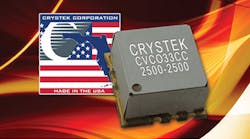Model CVCO33CC-2500-2500 is a voltage-controlled oscillator (VCO) for use at 2.5 GHz. It typically draws 20 mA from a +3.3-VDC supply and tunes (minimally) across a range of 0 to +3.3 VDC with typical tuning sensitivity of 10 MHz/V. It provides at least +5-dBm output power with typical pushing of 1 MHz/V. The VCO exhibits typical spurious content of -20 dBc with typical phase noise of -105 dBc/Hz offset 10 kHz from the carrier and -145 dBc/Hz offset 1 MHz from the carrier. It is supplied in a surface-mount package measuring 0.300 × 0.300 × 0.175 in. and designed for operating temperatures from -20 to +70°C.
Crystek Corp., 12730 Commonwealth Dr., Fort Myers, FL 33913; (239) 561-3311, (800) 237-3061, FAX: (239) 561-1025
Sponsored Recommendations
Sponsored Recommendations
Sponsored
Sponsored
